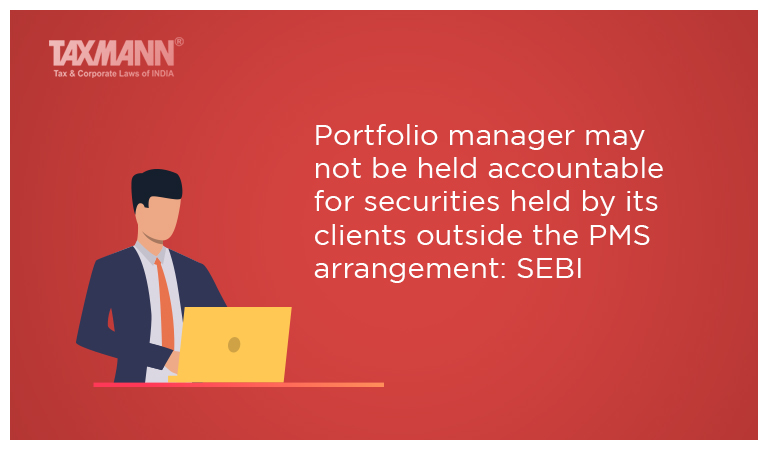Portfolio manager may not be held accountable for securities held by its clients outside the PMS arrangement: SEBI
- Blog|News|Company Law|
- 2 Min Read
- By Taxmann
- |
- Last Updated on 22 July, 2022
SEBI Informal Guidelines SEBI/HO/MRD2/MRD2DDAP/P/OVV/2022/028927/1/2022, Dated: 18.07.2022
M/s Club Millionaire Financial Services Pvt Ltd sought an interpretative letter under the SEBI (Informal Guidance) Scheme, 2003 on the issue that Whether the Portfolio Manager is accountable for the securities held by PMS (Portfolio Management Services) investors outside its PMS arrangement. SEBI clarified that a portfolio manager may not be held accountable for securities held by its clients outside the PMS arrangement.
Another query sought in an interpretive letter from SEBI is:
1. “Regulation 2(1) (q) of’ the SEBI (Substantial Acquisition of Shares and Takeovers) Regulations, 2011: Whether a portfolio manager and its client, who is an acquirer are to be considered as Person Acting in Concert (“PAC”) in the situation as mentioned above.
SEBI replied by quoting the definition of PAC that a Portfolio Manager along with its clients shall be deemed to be persons acting in concert unless the contrary is established. A portfolio manager advises or directs or undertakes on behalf of the client, the management and administration of the portfolio of securities of the clients. Moreover, regulation 22(1) of the PMS Regulations requires the portfolio managers to enter into an agreement with the client that defines their relationship, inter se and sets out their mutual rights, liabilities, and obligations. In case the securities are purchased outside the said PMS arrangement, the portfolio manager and its client may not be said to be PACs. The aforementioned understanding is without prejudice to the general definition of the term PAC as mentioned under Regulation 2(1)(q)(1) of the SAST Regulations.
2. Regulation 22(3) of SEBI (Depositories & Participants) Regulation 2018: Whether, in light of the above-mentioned facts, prior approval of the board has to be obtained for acquiring above 5% of the total paid-up equity capital of CDSL, in the capacity as a Portfolio manager?”
To this query, SEBI replied provision clearly states that a person who is eligible under regulations 21(1) and 21(2) of the DP Regulations is required to obtain prior approval from SEBI for acquiring or holding more than 5% of paid-up equity share capital in a depository. Therefore, prior approval of the Board is required only when the holding exceeds 5%, according to the agreement between the portfolio manager and the client.
Click Here To Read The Full Guideline
Disclaimer: The content/information published on the website is only for general information of the user and shall not be construed as legal advice. While the Taxmann has exercised reasonable efforts to ensure the veracity of information/content published, Taxmann shall be under no liability in any manner whatsoever for incorrect information, if any.

Taxmann Publications has a dedicated in-house Research & Editorial Team. This team consists of a team of Chartered Accountants, Company Secretaries, and Lawyers. This team works under the guidance and supervision of editor-in-chief Mr Rakesh Bhargava.
The Research and Editorial Team is responsible for developing reliable and accurate content for the readers. The team follows the six-sigma approach to achieve the benchmark of zero error in its publications and research platforms. The team ensures that the following publication guidelines are thoroughly followed while developing the content:
- The statutory material is obtained only from the authorized and reliable sources
- All the latest developments in the judicial and legislative fields are covered
- Prepare the analytical write-ups on current, controversial, and important issues to help the readers to understand the concept and its implications
- Every content published by Taxmann is complete, accurate and lucid
- All evidence-based statements are supported with proper reference to Section, Circular No., Notification No. or citations
- The golden rules of grammar, style and consistency are thoroughly followed
- Font and size that’s easy to read and remain consistent across all imprint and digital publications are applied








 CA | CS | CMA
CA | CS | CMA


